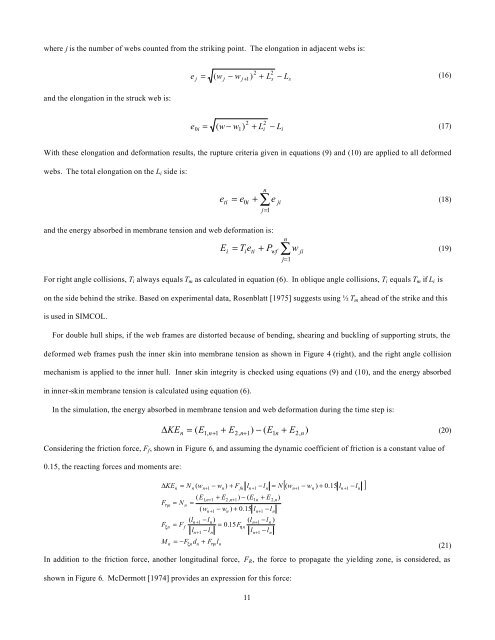Probabilistic Method for Predicting Ship Collision Damage
Probabilistic Method for Predicting Ship Collision Damage
Probabilistic Method for Predicting Ship Collision Damage
Create successful ePaper yourself
Turn your PDF publications into a flip-book with our unique Google optimized e-Paper software.
where j is the number of webs counted from the striking point. The elongation in adjacent webs is:ej= w j − w j+22s( 1) + L − L(16)sand the elongation in the struck web is:e20 i = w − w1)2i( + L − L(17)iWith these elongation and de<strong>for</strong>mation results, the rupture criteria given in equations (9) and (10) are applied to all de<strong>for</strong>medwebs. The total elongation on the L i side is:eti= e+n∑e0 i ji(18)j=1and the energy absorbed in membrane tension and web de<strong>for</strong>mation is:Ei= T eiti+ Pn∑wfj=1wji(19)For right angle collisions, T i always equals T m as calculated in equation (6). In oblique angle collisions, T i equals T m if L i ison the side behind the strike. Based on experimental data, Rosenblatt [1975] suggests using ½ T m ahead of the strike and thisis used in SIMCOL.For double hull ships, if the web frames are distorted because of bending, shearing and buckling of supporting struts, thede<strong>for</strong>med web frames push the inner skin into membrane tension as shown in Figure 4 (right), and the right angle collisionmechanism is applied to the inner hull. Inner skin integrity is checked using equations (9) and (10), and the energy absorbedin inner-skin membrane tension is calculated using equation (6).In the simulation, the energy absorbed in membrane tension and web de<strong>for</strong>mation during the time step is:∆ KE n = ( E1,n+ 1 + E2,n+1)− ( E1n+ E2,n)(20)Considering the friction <strong>for</strong>ce, F f , shown in Figure 6, and assuming the dynamic coefficient of friction is a constant value of0.15, the reacting <strong>for</strong>ces and moments are:∆KEFηnFξnMnn= N= F= N ( wnfn( llξnn + 1n + 1nn+1( E=( w1, n+1n + 1= −Fd + F l− w ) + Fnηnnn+ E2 , n+1nfn− ln)= 0.15F− lηn[(w − w ) + 0.15 l − l ]In addition to the friction <strong>for</strong>ce, another longitudinal <strong>for</strong>ce, F R , the <strong>for</strong>ce to propagate the yielding zone, is considered, asshown in Figure 6. McDermott [1974] provides an expression <strong>for</strong> this <strong>for</strong>ce:11n + 1) − ( E( ll1n− w ) + 0.15 lln+1n+1n+1− ln+ E− l2, nnn− ln)− l= N)n+1nn + 1n(21)
















